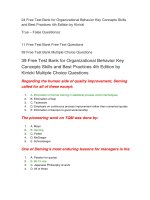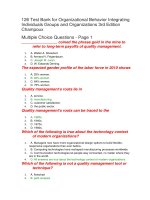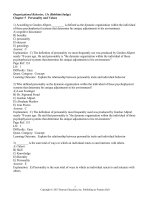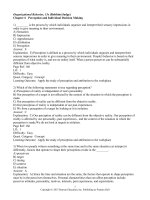Lecture Organizational behavior - Chap 13: Power and politics
Bạn đang xem bản rút gọn của tài liệu. Xem và tải ngay bản đầy đủ của tài liệu tại đây (3.85 MB, 25 trang )
Chapter 13
The Leadership Process
Leadership springs from
relationships
Chapter 13 Study Questions
What is leadership?
What is followership?
What do we know about leader-follower
relationships?
What do we mean by leadership as a collective
process?
Copyright © 2014 John Wiley & Sons,
13-2
What is leadership?
Leadership
• An influence process generated in and from
combined acts of leading (influencing) and
following (deferring) as social agents work
together to understand and agree about what
needs to be done and how to do it.
Copyright © 2014 John Wiley & Sons,
13-3
Figure 13.1 The role of “willing
followership” in leadership.
Copyright © 2014 John Wiley &
13-4
What is leadership?
Formal leadership
Exerted by persons appointed (or elected) to
positions of formal authority in organizations.
Informal leadership
Exerted by persons who become influential
because they have special skills that meet the
of others.
Copyrightresource
© 2014 Johnneeds
Wiley & Sons,
13-5
What is leadership?
Upward Leadership
• Occurs when leaders within
the organization influence
those at higher levels in ways
that create change.
Copyright © 2014 John Wiley & Sons,
13-6
What is leadership?
Leadership as Social Construction
• Socially Constructed
Leadership is constructed and produced in
social and relational interactions among
people acting in context.
Copyright © 2014 John Wiley & Sons,
13-7
What is leadership?
Leadership as Identity Construction
• Identity Construction Process
This process involves individuals negotiating
identities as leaders and followers.
• Claiming refers to actions people take to assert
their identity as a leader or follower.
• Granting refers to actions people take to
bestow an identity of a leader or follower onto
another person.
Copyright © 2014 John Wiley & Sons,
13-8
Figure 13.2 DeRue and Ashford
Leadership Identity Construction
Process
Copyright © 2014 John Wiley &
13-9
What is leadership?
Motivation to Lead
• The extent to which individual choose to
assume leadership training, roles and
responsibilities.
Copyright © 2014 John Wiley & Sons,
13-
What is leadership?
Implicit Leadership Theories
• Our beliefs or understanding about the attributes
associated with leaders and leadership.
Copyright © 2014 John Wiley & Sons,
13-
What is followership?
Followership
• The capacity or willingness to follow a leader.
Copyright © 2014 John Wiley & Sons,
13-
What is followership?
Romance of Leadership
• Refers to the tendency to attribute organizational
outcomes (both good and bad) to the acts and
doing of leaders.
Copyright © 2014 John Wiley & Sons,
13-
What is followership?
Follower Role Orientation
• Defined as the beliefs followers hold about the way they
should engage and interact with leaders to meet the
needs of the work unit.
Power Distance Orientations
• The extent to which one accepts that power in
institutions and organizations is distributed unequally.
Constructive Follower Orientations
• Reflects the belief that followers should act in ways that
are helpful, useful and productive to leadership
outcomes.
Copyright © 2014 John Wiley & Sons,
13-
Figure 13.3 Followership in
context
Copyright © 2014 John Wiley &
13-15
In your experience…
In your current or former job, did your
manager behave the same way with each
of the people he/she managed?
• A=Yes, B=No
If no, what was different about the
relationships between the manager and
each employee?
Copyright © 2014 John Wiley & Sons,
13-16
What do we know about
leader-follower relationships?
Leadership categorization theory
• Implicit leadership theories preconceived notions about the
attributes (e.g., traits and behaviors) associated with
leaders.
They reflect the structure and content of “cognitive
categories” used to distinguish leaders from
nonleaders.
Attributes or leadership prototypes are mental images of the
characteristics that make a “good” leader, that a “real”
leader would possess.
Copyright © 2014 John Wiley & Sons,
13-
What do we know about leaderfollower relationships?
LeaderMember Exchange (LMX) Theory
The study of manager-subordinate
relationship quality.
Copyright © 2014 John Wiley & Sons,
13-
What do we know about leaderfollower relationships?
Social Exchange Theory
• Describes how relationships initiate and develop through
processes of exchange and reciprocity.
• Norm of reciprocity
Says that when one party does something for another,
that party is not indebted to the other until the
obligation is repaid.
Copyright © 2014 John Wiley & Sons,
13-
What do we know about leaderfollower relationships?
Equivalence
• Whether the amount given back is roughly the same as
what was received.
Immediacy
• How quickly the repayment is made.
Interest
• The motive behind the exchange.
Copyright © 2014 John Wiley & Sons,
13-
What do we know about leaderfollower relationships?
Idiosyncrasy Credits
• Refer to our ability to violate norms with others based on
whether we have enough “credits” to cover the violation.
Copyright © 2014 John Wiley & Sons,
13-21
What do we mean by leadership as
a collective process?
Collective leadership
• Represents view of leadership not as a property of
individuals and their behaviors but as a social
phenomenon constructed in interaction.
Copyright © 2014 John Wiley & Sons,
13-
What do we mean by leadership as
a collective process?
Distributed Leadership
• Sees leadership as a group
phenomenon that is distributed
among individuals.
Copyright © 2014 John Wiley & Sons,
13-
What do we mean by leadership as
a collective process?
CoLeadership
• Occurs when leadership is divided so that
on one person has unilateral power to lead.
Copyright © 2014 John Wiley & Sons,
13-24
What do we mean by leadership as
a collective process?
Shared Leadership
• Dynamic, interactive influence process among
team members working to achieve goals.
Copyright © 2014 John Wiley & Sons,
13-25









